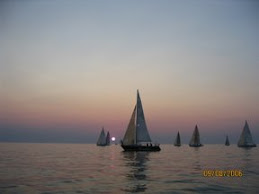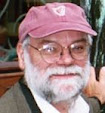I don't intend this to be a systematic piece on Over-the-Rhine, the old Cincinnati neighborhood north of Central Parkway (which at one time had been a canal). My living there happened at first by accident (or fate? Luck of the Irish?) and I had very little intellectual or social/political or religious agenda at first.
I moved to Cincinnati by invitation of Chris Cotter, my Notre Dame/Innsbruck Program friend. He invited me in late January of 1971, and I said yes more quickly than he could have expected. A few days later I drove my junker Ford Econoline van (a vehicle so eccentric only I could drive it) to Cincinnati. Chris had made some contacts with folks living in Over-the-Rhine (this began when he met Kenny Przybylski at Christ-in-the-Desert Monastery in Abiquiu, New Mexico; Ken invited Chris to come visit the Mansfield House Commune in Cincinnati).
For the first few days I stayed at Chris’s parents house in the Western Hills area of Cincinnati. This, to me, was luxurious living that I hadn’t experienced in our little home in Euclid, Ohio. Chris’s parents, Larry and Faye Cotter, were hospitable and generous, but Chris and I knew we had to find something that involved a simpler, more austere lifestyle, more in line with our values. It was our luck that Peggy Scherer and Anne Weinkam were getting ready to go on a very long road trip out West and needed someone to sublet their apartment, 225 Orchard Street in Over-the-Rhine (OTR). The apartment was not bad at all and the price was only $48/month--total! That was $24 per person. And we even had a responsive landlord. If memory serves, he was an Irish plumber who owned some old buildings in OTR. His last name might have been Dougherty. Chris and I immediately moved in to this “furnished” apartment--it was furnished but pretty simple. I think there was a kitchen table, a few chairs, a davenport, two beds, and not much more. I learned at one time that the chest of drawers Peggy and Anne left behind had belonged to Shirley Gallahan. I used it in Cincinnati, Pippa Passes, Kentucky, Berea, Kentucky, Euclid, Ohio, and Chardon, Ohio. About 10 years ago we bought a new Amish-built chest of drawers and gave Shirley's away.
Across Sycamore Street from our apartment was the Mansfield House, a commune of about 6-10 people . . . [more about that in another blog entry].
I loved Over-the-Rhine and explored it very thoroughly. Here are some favorite places and memories:
There was a little bakery near where I lived: north across Liberty and a block west to Main Street, then right around the corner on Main Street or possibly E. Clifton. This bakery sold donuts in the early morning right out of the grease for 7 cents a piece! (1971 prices). They were delicious, and police officers, firefighters, and ordinary working folks lined up to buy them. And I did too!
There was a great bluegrass music bar on Main Street near 13th, "Aunt Maudie's Country Garden." They had the best live bluegrass a few nights a week, no cover charge. Usually you'd hear The Stoney Mountain Boys, with Boatwhistle on acoustic bass (his real name was Vernon McIntyre Sr.); Earl Taylor on mandolin; Jim McCall on rhythm guitar; and Junior McIntyre on five-string banjo. They all sang. They were magnificent, maybe the best bluegrass band in the world. I almost got shot at Aunt Maudie’s one time! but that’s a story for a different time.
There was a fine religious bookstore on the east side of Vine Street about a hundred feet north of Liberty. It might have been called St. Francis Bookstore. I loved to browse in this progressive book shop and I remember well the highly informed store manager (her name might have been Mary).
A block or two north of the bookstore was Stenger's Cafe. I especially remember an occasional treat they had--homemade potato pancakes. They were fabulous. They also had wonderful, affordable roast beef sandwiches. I can still picture the proprietor, though I can’t remember his name. This was a great neighborhood bar and restaurant.
Across the street from Stenger's was Bolte's. They sold dried beans, peas, lentils, whole wheat flour, spices, herbs, things like that. The prices were good and the quality was good. I don’t know how they could sell enough to stay in business. What a great resource for the community!
A block west of Bolte's was The Findlay Market. I did shop there often enough. Sometimes we’d go there at the end of the day when they were practically giving away unsold fruit and vegetables. This market was something like Cleveland’s West Side Market. The vendors were local and many had been there for years.
The Empire Theater, near the corner of Vine and Liberty. You might think I’m crazy for including this funky place. Joanie Levy first took the Mansfield/Orchard Street gang there to see Clint Eastwood Spaghetti Westerns. The nice thing about this theatre is that it was air-conditioned. OTR was sweltering in the summer, and this was a place you could get relief for a couple hours. Unfortunately, your feet stuck to the floor in this theatre! Oh well . . .
12th Street Clinic. Also known as “Pilot City Health Service,” PCHS was a model for the future of medicine. It was a small but comprehensive clinic with general-practice physicians, a dentist, social workers, sanitarians, visiting nurses and aides, and a health education department (that’s where I worked 1971-73). Dale White DDS was the best dentist around. The social workers, Tom DeFolco and Mark were excellent (Tom later became a priest). I just recently heard of some unfortunate attitudes some of the doctors and nurses had, discouraging breastfeeding. That must have been an attitude of that era. It was unfortunate but not universal at PCHS. I know that because I assisted Becky Meyers, RN in teaching a class for new and expectant parents, and we promoted breastfeeding. The 12th Street Clinic had fees based on the ability to pay, a sliding scale, and was led by Dr. Joe Alter, who, I believe, had been a Conscientious Objector because of his Quaker beliefs during World War II. He was a terrific leader.
The Bank Cafe, 12th Street and Vine. This was an ordinary buffet-style restaurant, very busy, full of life. It was inexpensive and occasionally I’d get a hamburger there. I’d order it with everything on it, and the waiter would yell to the cook, “Burger through the garden!”
Washington Park. I walked through Washington Park (at 12th Street, between Elm and Race Streets) every day for a couple years when I worked at the 12th Street Clinic. Back in the early 1970s there were lots of alcoholics hanging around the park and I saw some unfortunate incidents there. Later, I attended some political demonstrations in the park, the last one being a memorial for Buddy Grey circa November 1996. That was the last time I saw Maurice McCrackin. I think I saw Kathleen Prudence there that day too.
Music Hall. This, of course, is the home of the Cincinnati Symphony Orchestra. It must be the most impressive building in OTR, and, completed in 1878, kept hundreds of bricklayers, masons, plasterers, painters, woodworkers, and other craftspeople busy for years creating this master work. For a long time this was probably one of the few connections between Cincinnati’s upper-middle class and OTR. That, of course, has changed with the astonishing gentrification of OTR that’s been going on for many years now.
Seventh Seal Bar. This was a very strange bar on McMicken Street in OTR run by a fellow named Ted (for some reason I think he was a former priest). This was Ken Przybylski’s favorite bar and I was in there many times with the Mansfield House/Orchard Street folks. There was nothing particularly memorable about it except that I was there with my friends. And it had a strange name, I think from a famous art film by Ingmar Bergman.
Old St. Mary’s. St. Mary’s might be the oldest or one of the oldest Catholic churches in Cincinnati (built 1841). I only went to mass there a couple times (and I believe they had mass in English, German, and Italian!). St. Mary’s was also the place where we went when we were “jumping” for Meals on Wheels, so it served to a certain extent as a social center for the neighborhood. About a block from the church was the Bible Center, which became for a while a Drop-In Center for many folks in the OTR area. I’ve been working with Homeless folks many years in Painesville, Ohio, up in Lake County, and a drop-in center is about the most needed thing for homeless people. They often have nowhere to go during the day and during bad weather. Old St. Paul’s. I was never in St. Paul’s Church in the Pendleton area of OTR when it was an active church. But I was there plenty of times after it had been decommissioned. I believe Jim Tarbell had been allowed to oversee the church and its incredible rectory. I occasionally slept at the rectory when I was between apartments, and I did some painting and plastering work there with Jack Shereda in the mid 1970s. I remember strtipping off about ten layers of old wallpaper before patching the plaster (Jack’s specialty) and painting. I especially remember the incredible bathrooms and showers in the old rectory, with multiple showerheads. It struck me that these priests lived at a level of luxury unknown to the regular folks in the neighborhood. Around 1976 we celebrated a wedding in the decommissioned church, that of Chris and Linda Cotter. I believe Rev. Hilaire Valiquette was the celebrant (in the de-commissioned church!). The reception party took place right afterwards in the church and the rooms behind the tabernacle. It was a fun and joyous event, and much alcohol was consumed. The highlight of the night was Dick Crowley’s attempt to recite a Pablo Neruda poem, “I Body of a Woman.” Dick intended it seriously, but his recitation was met with howls of laughter. Gee, I really miss the Dick Crowley I knew back in the 1970s. What a guy! One other thing just came to mind about St. Paul’s. There was a Ravi Shankar concert held there around 1976. I lived very close by, but didn’t have the ten bucks needed to attend the concert.
I realize my list is strange and eclectic. It probably reflects the point-of-view of an unmarried man in his twenties, which I was. My friends who were married or had children would almost certainly have a different list. And this list doesn’t talk much about the most important and remarkable thing about OTR, the people that lived and worked there.


